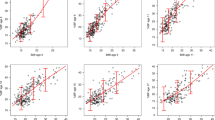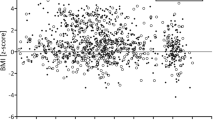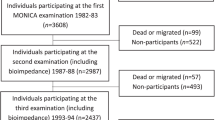Abstract
Background
Bioelectrical impedance (BIA) represents a simple, inexpensive and non-invasive method that is often used to assess fat-mass (FM) and fat-free mass (FFM) in large population-based cohorts.
Objective
The aim of this study was to describe the reference ranges and examine the influence of age and gender on FM, FFM and skeletal muscle mass (SMM) as well as height-adjusted estimates of FM [fat mass index (FMI)], FFM [fat-free mass index (FFMI)] and SMM [SMM index (SMI)] in a national, population-based cohort of Australian adults.
Design and Participants
The analytical sample included a total of 8,582 adults aged 25–91 years of Europid origin with complete data involved in the cross-sectional 1999–2000 Australian, Diabetes, Obesity and Lifestyle (AusDiab) Study.
Measurements
Bioelectrical impedance analysis was used to examine components of body composition. Demographic information was derived from a household interview.
Results
For both genders, FFM, SMM and SMI decreased linearly from the age of 25 years, with the exception that in men SMI was not related to age and FFM peaked at age 38 years before declining thereafter. The relative loss from peak values to ≥75 years in FFM (6–8%) and SMM (11–15%) was similar between men and women. For FM and FMI, there was a curvilinear relationship with age in both genders, but peak values were detected 6–7 years later in women with a similar relative loss thereafter. For FFMI there was no change with age in men and a modest increase in women.
Conclusion
In Australian adults there is heterogeneity in the age of onset, pattern and magnitude of changes in the different measures of muscle and fat mass derived from BIA, but overall the age-related losses were similar between men and women.
Similar content being viewed by others
References
Finucane MM, Stevens GA, Cowan MJ, Danaei G, Lin JK, Paciorek CJ et al. National, regional, and global trends in body-mass index since 1980: systematic analysis of health examination surveys and epidemiological studies with 960 country-years and 9.1 million participants. Lancet 2011; 377(9765): 557–567.
Wang YC, McPherson K, Marsh T, Gortmaker SL, Brown M. Health and economic burden of the projected obesity trends in the USA and the UK. Lancet 2011; 378(9793): 815–825.
World Health Organisation. Obesity: preventing and managing the global epidemic. Report of a WHO consultation. World Health Organ Tech Rep Ser 2000; 894: i–xii, 1–253.
National Health and Medical Research Council (NHMRC). Clinical Practice Guidelines for the Management of Overweight and Obesity in Adults. NHMRC: Canberra, 2003.
Kyle UG, Bosaeus I, De Lorenzo AD, Deurenberg P, Elia M, Gomez JM et al. Bioelectrical impedance analysis—part I: review of principles and methods. Clin Nutr 2004; 23(5): 1226–1243.
Marques-Vidal P, Bochud M, Mooser V, Paccaud F, Waeber G, Vollenweider P. Obesity markers and estimated 10-year fatal cardiovascular risk in Switzerland. Nutr Metab Cardiovasc Dis 2009; 19(7): 462–468.
Calling S, Hedblad B, Engstrom G, Berglund G, Janzon L. Effects of body fatness and physical activity on cardiovascular risk: risk prediction using the bioelectrical impedance method. Scand J Public Health 2006; 34(6): 568–575.
Nagaya T, Yoshida H, Takahashi H, Matsuda Y, Kawai M. Body mass index (weight/height 2) or percentage body fat by bioelectrical impedance analysis: which variable better reflects serum lipid profile? Int J Obes Relat Metab Disord 1999; 23(7): 771–774.
Lahmann PH, Lissner L, Gullberg B, Olsson H, Berglund G. A prospective study of adiposity and postmenopausal breast cancer risk: the Malmo Diet and Cancer Study. Int J Cancer 2003; 103(2): 246–252.
Baumgartner RN, Koehler KM, Gallagher D, Romero L, Heymsfield SB, Ross RR et al. Epidemiology of sarcopenia among the elderly in New Mexico. Am J Epidemiol 1998; 147(8): 755–763.
Janssen I. Influence of sarcopenia on the development of physical disability: the Cardiovascular Health Study. J Am Geriatr Soc 2006; 54(1): 56–62.
Janssen I, Heymsfield SB, Ross R. Low relative skeletal muscle mass (sarcopenia) in older persons is associated with functional impairment and physical disability. J Am Geriatr Soc 2002; 50(5): 889–896.
Newman AB, Kupelian V, Visser M, Simonsick E, Goodpaster B, Nevitt M et al. Sarcopenia: Alternative definitions and associations with lower extremity function. J Am Geriatr Soc 2003; 51(11): 1602–1609.
Goodpaster BH, Park SW, Harris TB, Kritchevsky SB, Nevitt M, Schwartz AV et al. The loss of skeletal muscle strength, mass, and quality in older adults: the health, aging and body composition study. J Gerontol A Biol Sci Med Sci 2006; 61(10): 1059–1064.
Visser M, Goodpaster BH, Kritchevsky SB, Newman AB, Nevitt M, Rubin SM et al. Muscle mass, muscle strength, and muscle fat infiltration as predictors of incident mobility limitations in well-functioning older persons. J Gerontol A Biol Sci Med Sci 2005; 60(3): 324–333.
Kalyani RR, Metter EJ, Ramachandran R, Chia CW, Saudek CD, Ferrucci L. Glucose and insulin measurements from the oral glucose tolerance test and relationship to muscle mass. J Gerontol A Biol Sci Med Sci 2012; 67(1): 74–81.
Enoki H, Kuzuya M, Masuda Y, Hirakawa Y, Iwata M, Hasegawa J et al. Anthropometric measurements of mid-upper arm as a mortality predictor for community-dwelling Japanese elderly: the Nagoya Longitudinal Study of Frail Elderly (NLS-FE). Clin Nutr 2007; 26(5): 597–604.
Wannamethee SG, Shaper AG, Lennon L, Whincup PH. Decreased muscle mass and increased central adiposity are independently related to mortality in older men. Am J Clin Nutr 2007; 86(5): 1339–1346.
Pietilainen KH, Kaye S, Karmi A, Suojanen L, Rissanen A, Virtanen KA. Agreement of bioelectrical impedance with dual-energy X-ray absorptiometry and MRI to estimate changes in body fat, skeletal muscle and visceral fat during a 12-month weight loss intervention. Br J Nutr 2012: 1–7.
Bosy-Westphal A, Later W, Hitze B, Sato T, Kossel E, Gluer CC et al. Accuracy of bioelectrical impedance consumer devices for measurement of body composition in comparison to whole body magnetic resonance imaging and dual X-ray absorptiometry. Obes Facts 2008; 1(6): 319–324.
Chumlea WC, Guo SS, Kuczmarski RJ, Flegal KM, Johnson CL, Heymsfield SB et al. Body composition estimates from NHANES III bioelectrical impedance data. Int J Obes Relat Metab Disord 2002; 26(12): 1596–1609.
Kyle UG, Genton L, Hans D, Karsegard L, Slosman DO, Pichard C. Age-related differences in fat-free mass, skeletal muscle, body cell mass and fat mass between 18 and 94 years. Eur J Clin Nutr 2001; 55(8): 663–672.
Dunstan DW, Zimmet PZ, Welborn TA, Cameron AJ, Shaw J, de Courten M et al. The Australian Diabetes, Obesity and Lifestyle Study (AusDiab)—methods and response rates. Diabetes Res Clin Pract 2002; 57(2): 119–129.
Tanita Corportaion. Bodyfat analyzer model TBF-105 instruction manual. Tanita Corporation,: Tokyo.
Tsui EY, Gao XJ, Zinman B. Bioelectrical impedance analysis (BIA) using bipolar foot electrodes in the assessment of body composition in Type 2 diabetes mellitus. Diabet Med 1998; 15(2): 125–128.
Brozek J, Grande F, Anderson JT, Keys A. Densitometric Analysis of Body Composition: Revision of Some Quantitative Assumptions. Ann N Y Acad Sci 1963; 110: 113–140.
Pevalin D, Robson K. The Stata Survival Manual, McGraw-Hill: New York, USA, 2009.
Weesie J. Analysis of the turning point of a quadratic specification. Stata technical bulletin 2001; 60: 18–20.
Ito H, Ohshima A, Ohto N, Ogasawara M, Tsuzuki M, Takao K et al. Relation between body composition and age in healthy Japanese subjects. Eur J Clin Nutr 2001; 55(6): 462–470.
Gallagher D, Visser M, De Meersman RE, Sepulveda D, Baumgartner RN, Pierson RN et al. Appendicular skeletal muscle mass: effects of age, gender, and ethnicity. Journal of applied physiology 1997; 83(1): 229–239.
Shaw KA, Srikanth VK, Fryer JL, Blizzard L, Dwyer T, Venn AJ. Dual energy X-ray absorptiometry body composition and aging in a population-based older cohort. Int J Obes 2007; 31(2): 279–284.
Sornay-Rendu E, Karras-Guillibert C, Munoz F, Claustrat B, Chapurlat RD. Age determines longitudinal changes in body composition better than menopausal and bone status: the OFELY study. J Bone Miner Res 2012; 27(3): 628–636.
Kim YS, Lee Y, Chung YS, Lee DJ, Joo NS, Hong D et al. Prevalence of Sarcopenia and Sarcopenic Obesity in the Korean Population Based on the Fourth Korean National Health and Nutritional Examination Surveys. The journals of gerontology. Series A, Biological sciences and medical sciences 2012.
Janssen I, Heymsfield SB, Wang ZM, Ross R. Skeletal muscle mass and distribution in 468 men and women aged 18–88 yr. J Appl Physiol 2000; 89(1): 81–88.
Janssen I, Heymsfield SB, Baumgartner RN, Ross R. Estimation of skeletal muscle mass by bioelectrical impedance analysis. Journal of applied physiology 2000; 89(2): 465–471.
Pichard C, Kyle UG, Bracco D, Slosman DO, Morabia A, Schutz Y. Reference values of fat-free and fat masses by bioelectrical impedance analysis in 3393 healthy subjects. Nutrition 2000; 16(4): 245–254.
Lu Y, Shu H, Zheng Y, Li C, Liu M, Chen Z et al. Comparison of fat-free mass index and fat mass index in Chinese adults. European journal of clinical nutrition 2012; 66(9): 1004–107.
Schutz Y, Kyle UU, Pichard C. Fat-free mass index and fat mass index percentiles in Caucasians aged 18–98 y. Int J Obes Relat Metab Disord 2002; 26(7): 953–960.
Gallagher D, Ruts E, Visser M, Heshka S, Baumgartner RN, Wang J et al. Weight stability masks sarcopenia in elderly men and women. Am J Physiol Endocrinol Metab 2000; 279(2): E366–E375.
Young A, Stokes M, Crowe M. Size and strength of the quadriceps muscles of old and young women. Eur J Clin Invest 1984; 14(4): 282–287.
Young A, Stokes M, Crowe M. The size and strength of the quadriceps muscles of old and young men. Clin Physiol 1985; 5(2): 145–154.
Bohm A, Heitmann BL. The use of bioelectrical impedance analysis for body composition in epidemiological studies. European journal of clinical nutrition 2013; 67 Suppl 1: S79–S85.
Kyle UG, Schutz Y, Dupertuis YM, Pichard C. Body composition interpretation. Contributions of the fat-free mass index and the body fat mass index. Nutrition 2003; 19(7–8): 597–604.
Waters DL, Baumgartner RN. Sarcopenia and obesity. Clin Geriatr Med 2011; 27(3): 401–421.
Kyle UG, Melzer K, Kayser B, Picard-Kossovsky M, Gremion G, Pichard C. Eight-year longitudinal changes in body composition in healthy Swiss adults. J Am Coll Nutr 2006; 25(6): 493–501.
Kim C-H, Chung S, Kim H, Park J-H, Park S-H, Ji JW et al. Norm references of fat-free mass index and fat mass index and subtypes of obesity based on the combined FFMI-%BF indices in the Korean adults aged 18–89yr. 2011; 5(3): e210–e219.
Obisesan TO, Aliyu MH, Bond V, Adams RG, Akomolafe A, Rotimi CN. Ethnic and age-related fat free mass loss in older Americans: the Third National Health and Nutrition Examination Survey (NHANES HI). BMC Public Health 2005; 5: 41.
Hull HR, Thornton J, Wang J, Pierson RN, Jr., Kaleem Z, Pi-Sunyer X et al. Fat-free mass index: changes and race/ethnic differences in adulthood. Int J Obes (Lond) 2011; 35(1): 121–127.
Chittawatanarat K, Pruenglampoo S, Kongsawasdi S, Chuatrakoon B, Trakulhoon V, Ungpinitpong W et al. The variations of body mass index and body fat in adult Thai people across the age spectrum measured by bioelectrical impedance analysis. Clin Interv Aging 2011; 6: 285–294.
Author information
Authors and Affiliations
Corresponding author
Rights and permissions
About this article
Cite this article
Strugnell, C., Dunstan, D.W., Magliano, D.J. et al. Influence of age and gender on fat mass, fat-free mass and skeletal muscle mass among Australian adults: The Australian diabetes, obesity and lifestyle study (AusDiab). J Nutr Health Aging 18, 540–546 (2014). https://doi.org/10.1007/s12603-014-0464-x
Received:
Accepted:
Published:
Issue Date:
DOI: https://doi.org/10.1007/s12603-014-0464-x




